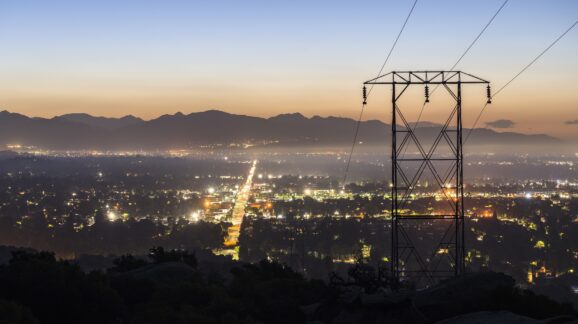Some Climate-Related Items that Recently Caught My Eye

Photo Credit: Getty
Manhattan Contrarian Francis “Buddy” Menton hit two homers this week. In “Don’t Be So Sure the Climate Extremists Have Won,” Menton offers hopeful words about the future of climate politics:
It does not really matter that the climate extremists at the moment control all of the commanding heights of our culture—the media, academia, most big corporations, and the Executive Branch of the government. What matters is that the cultists are proposing a new utopian energy system that will not work and cannot work. It’s only a question of when and how it fails—and of how big the political blowback will be when that happens. The main Achilles heel of the proposals is the problem of energy storage.
In the Energy Storage Conundrum, a report published by the Global Warming Policy Foundation, Menton zeroes in on that “Achilles heel.” From his blog summary:
The main point of the paper is that an electrical grid powered mostly by intermittent generators like wind and sun requires full backup from some source; and if that source is to be stored energy, the amounts of storage required are truly staggering. When you do the simple arithmetic to calculate the storage requirements and the likely costs, it becomes obvious that the entire project is completely impractical and unaffordable. The activists and politicians pushing us toward this new energy system of wind-solar-storage are either being intentionally deceptive or totally incompetent.
For example, Germany is planning a 20-fold expansion of its battery storage capacity by 2031. Sounds impressive. But achieving that goal will give Germany 8.81GWh of storage capacity, which is only 0.016 percent and 0.036 percent of the 25,000 to 37,000 GWh of capacity actually needed to provide fossil-free backup for an all wind + solar electric supply system.
Menton concludes:
Here’s what tells you all you need to know: not only is there no working demonstration project anywhere in the world of the wind/solar/storage energy system, but there is none under construction and none even proposed. Instead, the proponents’ idea is that your entire state or country is to be the guinea pig for their dreams. After all, they are “saving the planet.” If there has ever previously been something this crazy in the history of the world, I certainly can’t name it.
In “Siemens Power CEO Confirms the Iron Law of Power Density,” energy scholar Robert Bryce explicates Siemens CEO Christian Bruch’s terse comment that “renewables like wind roughly, roughly, need 10 times the material [compared to] … what conventional technologies need. … So if you have problems on the supply chain, it hits … wind extremely hard, and this is what we see.” The comment confirms what Bryce calls “the Iron Law of Power Density, which says the lower the power density of a given source, the higher the resource intensity.” That can be a big problem when resource costs go up. For example:
Siemens and other companies that produce wind turbines are being hammered by huge losses. Siemens just posted a net loss of 647 million euros, which was up from a 560-million-euro loss in the previous year. In October, GE announced that its renewable energy business will lose a staggering $2 billion this year. Those losses are being driven in large part, by the surging cost of metals like zinc, nickel, neodymium, and copper.
Resource intensity also exacerbates the increase in costs arising from supply-chain issues:
If your power plant requires 10 times more of those commodities than other forms of power generation, it’s readily apparent why the Siemens boss is saying his company is having “problems on the supply chain.” And those problems are a direct result of wind energy’s low power density. If you skipped high school physics as I did, you may not understand why power density matters. But it is perhaps the single most important metric when it comes to explaining the size and shape of our energy and power networks.
In his latest Energy Talking Points memo, philosopher and energy analyst Alex Epstein explains why ”Climate Reparations” Are Immoral:
“Climate reparations” are based on two false assumptions: 1. Free, wealthy countries, through their fossil fuel use, have made the world worse for poor countries. 2. The poor world’s main problem is dealing with climate change, which wealth transfers will help them with….
The progressive politicians and pundits who preach those messages get things exactly backwards. What rich countries should be communicating to poor countries, Epstein argues, is that “economic freedom is the path to prosperity,” and poor countries should reform their “cultural and political institutions to embrace economic freedom—including fossil fuel freedom.” Unfortunately, our leaders do the opposite. “Instead of promoting economic freedom, including fossil fuel freedom, wealthy ‘climate reparations’ advocates like John Kerry are offering to entrench anti-freedom regimes by paying off their dictators and bureaucrats to eliminate fossil fuel freedom.”
Last but not least, in November, University of Alabama in Huntsville atmospheric scientist Roy Spencer posted three data-rich analyses on his blog demonstrating that non-climatic influences continue to inject an upward bias in land-surface temperature records, despite claims that urban heat island effects have been removed. Specifically, Spencer’s analyses suggests that, over the past 50 years, urbanization accounts for about 20 percent of daytime and 50 percent of nighttime warming for the U.S. East Coast, Las Vegas, and the region encompassing Calgary and Edmonton in Canada.
I hope these summaries entice you to read the entire essays. The information and insights are valuable and you won’t find them in the Washington Post or New York Times.